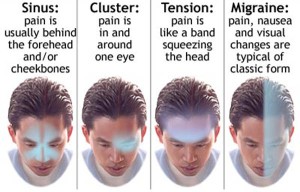Almost everyone has experienced a headache at least once in their
lives. It is, in fact, the most common form of pain. Headache is pain or discomfort felt in the head, scalp or neck. The pain initiates from the tissues and structures surrounding the brain. The brain has no nerves that give rise to pain sensation or pain fibers. When one experiences a headache, there is an irritation or inflammation of the tissues. There are different classifications of headaches, which will be further discussed in the article. Headaches are infrequently from serious causes. Needless to say, headache can be easily relieved by taking over-the-counter (OTC) painkillers.
Classifications and Causes of Headaches
A classification system is used to classify headaches. The new classification system aims to make easy classification and specific diagnosis, therefore giving for effectual options for treatment. The categories classified according to the source of pain
- Primary headaches (most common type of headaches)
- Tension (most common type of primary headache)
- Due to muscle contraction that cover the skull that lead to inflammation (exact cause is unknown)
- May be caused by stress, anxiety, depression, bad posture, etc.
- More common in women
- Tension (most common type of primary headache)
- Migraine (second most common type of primary headache)
- Exact cause unknown
- May be triggered by heat, lack of sleep, caffeine withdrawal, certain scents, etc.
- More common in women
- Cluster (rare type)
- Uncertain cause but predicted to be due to abrupt discharge or histamine and serotonin
- May be inherited
- More common in men
- Secondary headaches
- Symptom of a disease or due to underlying problem in structures of the head or neck
- Causes:
- Stroke or transient ischemic attack
- Brain tumors
- Seizures
- Infections such as encephalitis or meningitis
- Hypertension, dehydration, etc
- Traumatic headaches
- Substance abuse
- Cranial neuralgias, facial pain and other headaches
- Inflammation of one of the 12 cranial nerves
Symptoms of Headaches
The pain from headachescan be dull ache, sharp, throbbing, constant, mild or intense. Moreover, the specific symptoms arising from headaches are different for each cause.
- Tension headaches
- Pain originates from the back of the head and upper neck spreading to encircle the head
- Most intense pain in the temples or over the eyebrows
- Bilateral pain that is not usually intense
- May occur often
- Migraine headaches
- Severe, throbbing or pounding pan pain accompanied by change in vision
- Nausea
- Cluster headaches
- Severe pain, once or twice a day, maybe even more, lasting from 30 minutes to 90 minutes
- Befalls daily for a week or longer, frequently at the same time of the day
- Eye redness, watery and inflammation
- Cranial neuralgias
- Causes severe facial pain
First Aid Treatment for Headaches

- Take plenty of rest, preferably in a dark room. Do not force self to take part in activities that may aggravate symptoms. If possible, lie down.
- Remove self from stressful environments.
- Drink plenty of fluids, especially water, to stay hydrated.
- A cool compress may be placed over the forehead.
Headaches can go away on their own without treatment. But giving adequate treatment can help relieve symptoms faster giving comfort to the person. Learn more about how to treat headaches and other head traumas or injuries in first aid training.